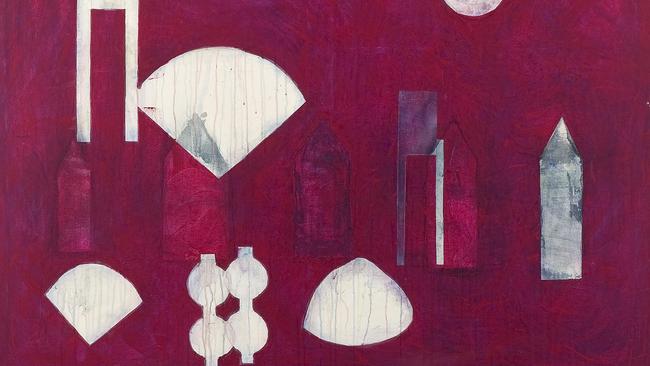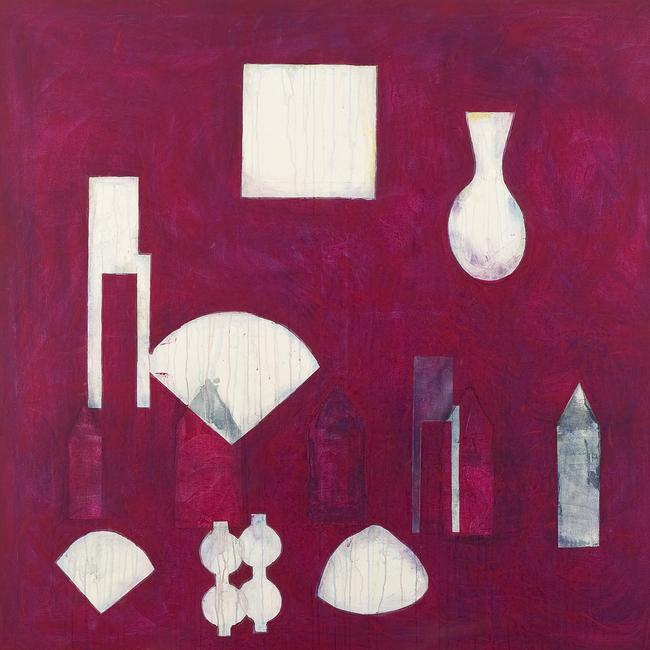TarraWarra Museum of Art’s focus on great women
One of Denise Green’s paintings is on show at the TarraWarra Museum of Art in Victoria as part of the Making Her Mark exhibition.

In the mid-1960s, Denise Green, then 19, decided to leave Australia and her job as an office worker in Brisbane and sail on the ocean liner SS Oronsay to London. However, she resisted the lure of London and soon made her way to Paris, where she studied at the Ecole des Beaux-Arts and the Sorbonne.
The real breakthrough came a few years later, however, in 1969, when she travelled to New York and studied with Mark Rothko and Robert Motherwell at Hunter College, at the City University of New York (CUNY). Under the influence of Rothko and Motherwell, she became known as a painter of motifs, such as the amphora, a house, or a fan, set against a minimal, monochrome background. For Green, these archetypal forms carry a range of symbolic values, which she once described as “vessels which carry emotions and ideas”.

Green’s work first gained attention in 1978 when she was shown in two groundbreaking exhibitions, Young American Artists at New York’s Guggenheim Museum, and New Image Painting, at the Whitney Museum of American Art. These shows launched her career. Since then she has exhibited extensively internationally and been in such demand that she’s had more than 130 one-person shows, 30 of which have been solo museum exhibitions.
Green still lives and works in New York but travels regularly to Europe, Asia and Australia. Despite her long stint in New York, she has said that her early years in Australia are key because “my first ideas about art were shaped in Australia and that remains part of my identity, a really important part”.
One of Green’s paintings, Story: Cobalto, from 2000, is currently on show at the TarraWarra Museum of Art in Healesville, Victoria, in an exhibition titled Making Her Mark: Selected Works from the Collection, which examines the work of leading women artists from the museum’s extensive collection.
At the museum, the director and curator, Victoria Lynn, says Green’s “highly evocative paintings are distinguished by their intriguing combination of different formal attributes, utilising abstract approaches to geometry, colour, and the flattening of the picture plane, together with expressive and gestural mark-making and reductive imagery”.
Green’s painting, Story: Cobalto, is a prime example of the artist’s work at the turn of the century, says Lynn. “Green incorporates a cluster of simple motifs of elongate chairs, vessels, houses and fans alongside the geometric shapes of squares, all hovering amid a rich, spacious field of crimson. The vivid and saturated colour of her canvases also carries personal meaning for the artist, not only in its salute to mentor Rothko, but through the influence of her visits to India and Bali, where she described colour as the ‘most vital force in the environment’.”
RELATED STORIES: Historical imbalance will finally be corrected | What’s on the culture calendar this March
Among a large offering of silver objects, a 19th-century French Japanese-style silver, niello and enamel comport dish, which was estimated to sell for between $10,000 and $15,000, surprised auction-goers when it fetched $54,970 (including buyer’s premium) at the recent decorative arts and collectables sale by Leski Auctions in Melbourne. The auction, held over two days, featured more than 1000 lots. The second-top sale was a Prussian majolica owl manufactured by Hugo Lonitz in the 1870s. With a pre-sale estimate of between $8000 and $10,000, it fetched $13,145. Another positive result was a triptych by Ozias Humphry (1742-1810) featuring King George III and the Prince of Wales reviewing the troops. The work, circa 1797, is handpainted on ivory panels with an original carved bone, mother of pearl and ivory frame. It also features portraits of Queen Charlotte and a seated King George III. The triptych was estimated to sell from $3000 to $5000 but realised $11,950. Another painting, of a reclining nude in the manner of British artist Sir Lawrence Alma-Tadema, also sold over its estimate for $9560. An Anglo-Indian carved ebony box with silver escutcheon and made in a town in Uttar Pradesh around 1866 sold for more than double its highest estimate for $7468.75. Considered extremely rare, a similar box is held in London’s Victoria and Albert Museum.



To join the conversation, please log in. Don't have an account? Register
Join the conversation, you are commenting as Logout